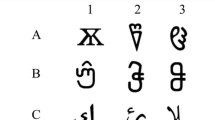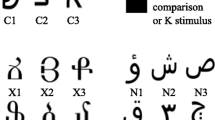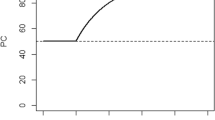Abstract
Six pairs of participants were matched from a pool of 26 participants based on their performance in pretraining for conditional discrimination. One participant from each pair completed either a speed or an accuracy condition in the conditional discrimination training by using an linear series (LS) structure to establish potentially three, 3-member classes. Initially, the speed participants completed the training with a titrating limited hold (LH) on the comparison stimuli. The accuracy participants were yoked to the trial number of the speed participants with whom they were matched. In Phase 2, the speed participants completed matching to sample (MTS) training with a fixed 1,000-ms LH, and the accuracy participants were not yoked. In Phase 3, the probabilities of the programmed consequences were gradually reduced to 0 %. Phase 4 introduced tests for baseline and emergent relations and adduction. In Phase 5, a 2-week retention test was administered. The results indicated that 1 of 6 speed participants, compared with 3 of 6 accuracy participants, responded according to stimulus equivalence in the initial testing, whereas accuracy in the adduction test was nearly equal for all participants. In a 2-week retention test, no accuracy participants and two speed participants responded according to stimulus equivalence, whereas accuracy in the adduction test was equal between the participants. In the second retention test, 1 of 3 speed participants responded in accord with stimulus equivalence. All speed participants had a higher number of errors during the baseline trials and completed a higher number of acquisition trials. Inverse reaction time (InvRT) to comparisons did not vary as a function of trial type.








Similar content being viewed by others
Notes
One participant was unable to complete the pretraining and did not move into the experimental phases. One speed participant was unable to complete Phase 1, and another speed participant did not complete Phase 2. Two of the remaining speed participants were dropped from the analysis, as they could not be matched.
One participant was unable to complete the pretraining. Three speed participants were unable to complete Phase 1, and one speed participant did not complete Phase 2. Four of the remaining speed participants were dropped from the analysis, as they could not be matched. One participant was tested over two consecutive days.
References
Arntzen, E. (2004). Probability of equivalence formation: Familiar stimuli and training sequence. The Psychological Record, 54, 275–291. Retrieved from http://thepsychologicalrecord.siuc.edu/index.html.
Arntzen, E., & Hansen, S. (2011). Training structures and the formation of equivalence classes. European Journal of Behavior Analysis, 12, 483–503. Retrieved from http://www.ejoba.org/.
Arntzen, E., & Haugland, S. (2012). Titration of limited hold to comparison in conditional discrimination. The Psychological Record, 62, 243–262. Retrieved from http://thepsychologicalrecord.siuc.edu/index.html.
Arntzen, E., & Holth, P. (1997). Probability of stimulus equivalence as a function of training design. The Psychological Record, 47, 309–320. Retrieved from http://thepsychologicalrecord.siuc.edu/index.html.
Arntzen, E., & Holth, P. (2000a). Equivalence outcome in single subjects as a function of training structure. The Psychological Record, 50, 603–628. Retrieved from http://thepsychologicalrecord.siuc.edu/index.html.
Arntzen, E., & Holth, P. (2000b). Probability of stimulus equivalence as a function of class size vs. number of classes. The Psychological Record, 50, 79–104. Retrieved from http://thepsychologicalrecord.siuc.edu/index.html.
Arntzen, E., & Lian, T. (2010). Trained and derived relations with pictures as nodes. The Psychological Record, 60, 659–677. Retrieved from http://thepsychologicalrecord.siuc.edu/index.html.
Arntzen, E., & Nikolaisen, S. L. (2011). Establishing equivalence classes in children using familiar and abstract stimuli and many-to-one and one-to-many training structures. European Journal of Behavior Analysis, 12, 105–120. Retrieved from http://www.ejoba.org/.
Arntzen, E., Grondahl, T., & Eilifsen, C. (2010a). The effects of different training structures in the establishment of conditional discriminations and the subsequent performance on the tests for stimulus equivalence. The Psychological Record, 60, 437–462. Retrieved from http://thepsychologicalrecord.siuc.edu/index.html.
Arntzen, E., Halstadtro, L. B., Bjerke, E., & Halstadtro, M. (2010b). Training and testing theoretical music skills in a boy with autism using a matching-to-sample format. Behavioral Interventions, 25, 129–143. doi:10.1002/bin.301.
Arntzen, E., Nartey, R. K., & Fields, L. (2014). Identity and delay functions of meaningful stimuli and enhanced equivalence class formation. The Psychological Record, 64, 349–360. doi:10.1007/s40732-014-0066-3.
Baron, A. (1985). Measurement scales and the age-complexity hypothesis. Experimental Aging Research, 11, 193–199. doi:10.1080/03610738508259187.
Bentall, R. P., Dickins, D. W., & Fox, S. R. A. (1993). Naming and equivalence: Response latencies for emergent relations. The Quarterly Journal of Experimental Psychology: Comparative and Physiological Psychology, 46B, 187–214. doi:10.1080/14640749308401085.
Bentall, R. P., Jones, R. M., & Dickins, D. W. (1999). Errors and response latencies as a function of nodal distance in 5-member equivalence classes. The Psychological Record, 49, 93–115. Retrieved from http://thepsychologicalrecord.siuc.edu/index.html.
Bucklin, B. R., Dickinson, A. M., & Brethower, D. M. (2000). A comparison of the effects of fluency training and accuracy training on application and retention. Performance Improvement Quarterly, 13, 140–163. doi:10.1111/j.1937-8327.2000.tb00180.x.
Dymond, S., & Rehfeldt, R. A. (2001). Supplemental measures and derived stimulus relations. Experimental Analysis of Human Behavior Bulletin, 19, 8–12. Retrieved from http://www.eahb.org/NewSitePages/BulletinHomepage.htm.
Eilifsen, C., & Arntzen, E. (2009). On the role of trial types in tests for stimulus equivalence. European Journal of Behavior Analysis, 10, 187–202. Retrieved from http://www.ejoba.org/.
Fields, L., & Garruto, M. (2009). Optimizing linked perceptual class formation and transfer of function. Journal of the Experimental Analysis of Behavior, 91, 225–251. doi:10.1901/jeab.2009.91-225.
Fields, L., & Verhave, T. (1987). The structure of equivalence classes. Journal of the Experimental Analysis of Behavior, 48, 317–332. doi:10.1901/jeab.1987.48-317.
Fields, L., Landon-Jimenez, D. V., Buffington, D. M., & Adams, B. J. (1995). Maintained nodal-distance effects in equivalence classes. Journal of the Experimental Analysis of Behavior, 64, 129–145. doi:10.1901/jeab.1995.64-129.
Fields, L., Arntzen, E., Nartey, R. K., & Eilifsen, C. (2012). Effects of a meaningful, a discriminative, and a meaningless stimulus on equivalence class formation. Journal of the Experimental Analysis of Behavior, 97, 163–181. doi:10.1901/jeab.2012.97-163.
Holth, P., & Arntzen, E. (1998a). Stimulus familiarity and the delayed emergence of stimulus equivalence or consistent nonequivalence. The Psychological Record, 48, 81–110. Retrieved from http://thepsychologicalrecord.siuc.edu/index.html.
Holth, P., & Arntzen, E. (1998b). Symmetry versus sequentiality related to prior training, sequential dependency of stimuli, and verbal labeling. The Psychological Record, 48, 293–315. Retrieved from http://thepsychologicalrecord.siuc.edu/index.html.
Holth, P., & Arntzen, E. (2000). Reaction times and the emergence of class consistent responding: A case for precurrent responding? The Psychological Record, 50, 305–338. Retrieved from http://thepsychologicalrecord.siuc.edu/index.html.
Horne, P. J., & Lowe, C. F. (1996). On the origins of naming and other symbolic behavior. Journal of the Experimental Analysis of Behavior, 65, 181–241. doi:10.1901/jeab.1996.65-185.
Hove, O. (2003). Differential probability of equivalence class formation following a one-to-many versus a many-to-one training structure. The Psychological Record, 53, 617–634. Retrieved from http://thepsychologicalrecord.siuc.edu/index.html.
Imam, A. A. (2001). Speed contingencies, number of stimulus presentations, and the nodality effect in equivalence formation. Journal of the Experimental Analysis of Behavior, 76, 265–288. doi:10.1901/jeab.2001.76-265.
Imam, A. A. (2003). Assessing transfer of response speed and nodality via conditional discriminations. Experimental Analysis of Human Behavior Bulletin, 21, 1–7. Retrieved from http://www.eahb.org/NewSitePages/BulletinHomepage.htm.
Imam, A. A. (2006). Experimental control of nodality via equal presentations of conditional discriminations in different equivalence protocols under speed and no-speed conditions. Journal of the Experimental Analysis of Behavior, 85, 107–124. doi:10.1901/jeab.2006.58-04.
Lyddy, F., Barnes-Holmes, D., & Hampson, P. J. (2000). The effect of stimulus meaningfulness on the formation of equivalence classes. European Journal of Behavior Analysis, 1, 71–87. Retrieved from http://www.ejoba.org/.
Rehfeldt, R. A., & Hayes, L. J. (2000). The long-term retention of generalized equivalence. The Psychological Record, 50, 405–428. Retrieved from http://thepsychologicalrecord.siuc.edu/index.html.
Rehfeldt, R. A., & Root, S. (2004). The generalization and retention of equivalence relations in adults with mental retardation. The Psychological Record, 54, 173–186. Retrieved from http://thepsychologicalrecord.siuc.edu/index.html.
Saunders, R. R., Wachter, J. A., & Spradlin, J. E. (1988). Establishing auditory stimulus control over an eight-member equivalence class via conditional discrimination procedure. Journal of the Experimental Analysis of Behavior, 49, 95–115. doi:10.1901/jeab.1988.49-95.
Sidman, M. (1992). Equivalence relations: Some basic considerations. In S. C. Hayes & L. J. Hayes (Eds.), Understanding verbal relations (pp. 15–27). Reno: Context Press.
Sidman, M. (2000). Equivalence relations and the reinforcement contingency. Journal of the Experimental Analysis of Behavior, 74, 127–146. doi:10.1901/jeab.2000.74-127.
Sidman, M., & Tailby, W. (1982). Conditional discrimination vs. matching to sample: An expansion of the testing paradigm. Journal of the Experimental Analysis of Behavior, 37, 5–22. doi:10.1901/jeab.1982.37-5
Spencer, T. J., & Chase, P. N. (1996). Speed analysis of stimulus equivalence. Journal of the Experimental Analysis of Behavior, 65, 643–659. doi:10.1901/jeab.1996.65-643.
Tomanari, G. Y., Sidman, M., Rubio, A. R., & Dube, W. V. (2006). Equivalence classes with requirements for short response latencies. Journal of the Experimental Analysis of Behavior, 85, 349–369. doi:10.1901/jeab.2006.107-04.
Wang, T., Dack, C., Whelan, R., & McHugh, L. (2011). Preserved nodal number effects under equal reinforcement. Learning and Behavior, 39, 224–238. doi:10.3758/s13420-011-0020-z.
Whelan, R. (2008). Effective analysis of reaction time data. The Psychological Record, 58, 475–482. Retrieved from http://thepsychologicalrecord.siuc.edu/index.html.
Wulfert, E., & Hayes, S. C. (1988). Transfer of conditional ordering response through conditional equivalence classes. Journal of the Experimental Analysis of Behavior, 50, 125–144. doi:10.1901/jeab.1988.50-125.
Author note
There is no conflict of interest to declare for either of the authors. Correspondence concerning this manuscript should be addressed to Erik Arntzen, Oslo and Akershus University College, Department of Behavioral Science, St. Olavs Plass, PO Box 4, 0130 Oslo, Norway. E-Mail: erik.arntzen@equivalence.net. Petur Ingi Petursson is currently affiliated with Ullevålsveien 34, Oslo Kommune Velferdsetaten Postboks 7104 St. Olavs plass 0130 Oslo.
Author information
Authors and Affiliations
Corresponding author
Rights and permissions
About this article
Cite this article
Arntzen, E., Petursson, P.I., Sadeghi, P. et al. Equivalence Class Formation in Accuracy or Speed Conditions: Immediate Emergence, Adduction, and Retention. Psychol Rec 65, 141–159 (2015). https://doi.org/10.1007/s40732-014-0097-9
Published:
Issue Date:
DOI: https://doi.org/10.1007/s40732-014-0097-9




